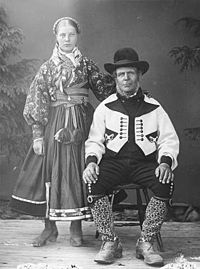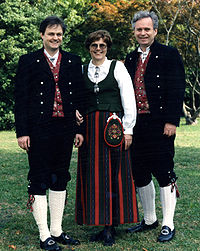CULTURA: EL BUNAD. A bunad is a traditional Norwegian costume, typically of rural origin. Bunads are local to Norway's traditional districts, and the result both of traditional evolution and organized efforts to discover and modernize traditional designs. The designs are typically elaborate, with embroidery, scarves, shawls and hand-made silver or gold jewellery. There are bunads both for men and women, although women's bunads are more diverse and popular.
Bunad
From Wikipedia, the free encyclopedia
| This article does not cite any references or sources. Please help improve this article by adding citations to reliable sources. Unsourced material may be challenged and removed. (April 2008) |
A bunad is a traditional Norwegian costume, typically of rural origin. Bunads are local to Norway's traditional districts, and the result both of traditional evolution and organized efforts to discover and modernize traditional designs. The designs are typically elaborate, with embroidery, scarves, shawls and hand-made silver or gold jewellery. There are bunads both for men and women, although women's bunads are more diverse and popular.
Contents[hide] |
[edit] Bunad traditions in Norway
In Norway, it is common to wear bunad as a costume at various celebrations, especially the May 17 National Day celebrations. In recent years, its use has reached far outside folk dancing, folk music, and particular holidays. Accepted as proper gala attire, it is increasingly common to see people, and especially women, dressed in bunad. The former Norwegian foreign minister, Thorvald Stoltenberg, created history by presenting his accreditation as ambassador to Margrethe II of Denmark dressed in a bunad.
There is ongoing debate about the official status of various outfits, and what allowed variations are. In 1947 an official institution was organized to act in an advisory capacity on all questions dealing with bunads in Norway, the Landsnemda for Bunadspørsmål. Due to ongoing discussions on the status of bunads, it is not possible to state accurately the number of different types of bunads in Norway, but most estimates place the number at around 200.
[edit] Design and origins of bunad
The various bunads have been designed through different means. Some of them are based on old local customs; other models are reconstructions made in the 20th century, relying on local and historical material. The interest for bunads dates back to Norwegian romantic nationalism and gained increasing interest with the folk-dance movement at the beginning of the 20th century.
In some parts of the country, folk-costume tradition was alive as early as the 19th century. Bunads with such long traditions are to be Gudbrandsdal]], and at Røros in eastern Norway.
Hulda Garborg (1862–1934) and Klara Semb (1884–1970) are cited as pioneers in bringing bunad into mainstream culture. With Garborg's publication of the pamphlet Norsk Klædebunad in 1903, the focus moved from the creation of a single national costume to the development of several regional bunads. Although bunads are based on traditions in various areas, these designs are embellished by additions such as embroidery. The overarching sense of bunad design is to preserve the way people dressed for festive occasions in one particular era. This has led local and national councils to impose official constraints on various details in the bunad, including colors, fabric, embroidery, jewellery, cut, and allowable headwear.
[edit] The bunad movement

The bunad movement has been carried forward by enthusiasts all over the country and new bunad variations are frequently created and proposed for approval. Designers such as Lise Skjåk Bræk have developed entire lines of costumes based on the bunad tradition.
In the field of folk costumes it is common to differentiate between bunad and folk costume, the latter being the local dress in previous times with all its variations and use. Bunads are used for festive occasions and today they date back to the folk costume tradition of the 19th century.
There is a continuing debate about the extent to which bunads must conform to the standards, or whether it is acceptable to vary or improvise based on general themes. Some groups (sometimes derisively referred to as the bunad police) argue that bunads must be sewn and worn according to strict standards; others advocate a more creative, lenient approach. Although these differing groups show little sign of reaching consensus, both factions agree that traditional under-garments—commonly known as frillies—should be worn with the Bunad.
Hulda Garborg (1862–1934) in bunad | From Hallingdal – painting by Gerhard Munthe (1890) | ||
Frieriet by Nils Bergslien | Nordic bunad and folk dress on Faroe Islands stamps | ||
Norwegian immigrants wearing their traditional outfit (bunad) | A man wearing a rogalandsbunad and holding the flag of Norway |
[edit] External links
- Pictures of bunads from different parts of Norway
- Telemarksbunads Bunads from Telemark. Pictures, history and information about the bunads from Telemark.
- Bunad - Norwegian National Costumes Article on My Little Norway
| ||||||||||||||||||||||||||||||||
| ||











0 comentarios